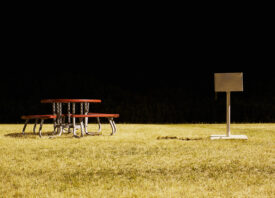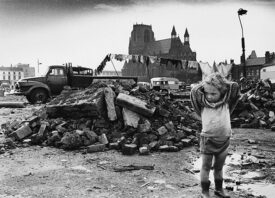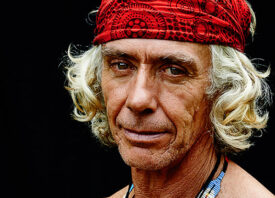Search this site
Solar Photograms Imagine a Haunting Vision of the Future



A few months ago, Francis Baker had a nightmare. “I had a vision of a hurricane of plastic junk swirling around and rushing by,” he remembers. In the dream, he held onto his loved ones to prevent getting consumed by the storm. In My Plastic Life, a series of solar photograms, the artist brings this scene and others like it to life through cameraless pictures created using plastic waste: single-use plastic bottles, shopping bags, bottle caps, and more.
In some images, a figure runs toward the horizon. In others, the ocean roils and burns like fire. Baker’s images are made on expired silver gelatin darkroom paper, dating back at least two decades. Baker creates his compositions under a safelight in the darkroom: for the ocean pictures, he layers shipping plastic to create the illusion of flowing water. To set everything in place, he places the paper between glass and plywood or glass and plexiglass before bringing it out into the sunlight.
Once outside, exposure times for these solar photograms generally run for five to six hours, depending on the weather and conditions. From there, the prints are brought inside and fixed in the darkroom—skipping the developer stage—and rinsed. The colors might vary depending on the objects used, their position and shape, the angle of the light, and the reflections falling across the paper.
“Darkroom paper has a spray of nano-silver gelatin particles,” the artist explains. “Normally, the particles are glued together through development to form large visible black particles. In the print-out photogram, there is no developer used. The nano-silver matrix stays but is shifted, forming the colors.” As a result, the final solar photographs contain a range of lush violets, salmon pinks, solar yellows, burnt oranges, and, in some cases, sky blues.
While Baker has experimented with artificial light, the use of the sun itself is intentional and significant, as plastic use directly contributes to climate change. According to estimates, plastic production and incineration could account for 2.8 billion tons of greenhouse gas emissions by 2050. In marine environments, plastics not only destroy habitats but also release greenhouse gasses when they’re heated by sunlight.
“We cannot talk about climate change without talking about the sun,” Baker says. “My process uses the sun as its method of creation. The sun is at the core of this work. The power of the sun is moving the silver particles. It is human action that is destroying our protection from the sun, causing the dramatically heating environment.”
The artist first noticed the ubiquity of single-use plastics while walking through the desert in Coachella Valley to see the Desert X art exhibition. The water bottles found on that trail became the materials for some of his first forays into making photograms with plastic waste. Once he started looking, he found plastics everywhere: “You can come up with a bucketful just walking around a city block or a trip to the grocery store.”
At home, Baker reduces, reuses, and recycles to minimize single-use plastics and plastic waste, but he’s hoping his work will inspire change on a global and corporate level as well. “I feel that the plastics industry needs to be made to change,” he says. “There are alternatives to wrapping everything in plastic. Plastic refining is one of the fastest-growing sectors and if consumers can’t control it through purchasing power, then legislation needs to step in.”
Microplastics have been found almost everywhere on our planet, from towering mountains to the deepest waters of the ocean. They’re in our drinking water and in the air we breathe. They’ve even been found in human blood.
Throughout the solar photograms in My Plastic Life, the human body becomes a recurring motif, providing a visceral reminder of the estimated five grams of microplastics we eat on a weekly basis. In one image, a man and a woman, both nude, walk toward the horizon hand in hand. It’s unclear what’s waiting for them there—beneath the blistering sun.







All images © Francis Baker
If you liked this article, you might be interested in the work of Rebecca Najdowski, who also works with photograms.


